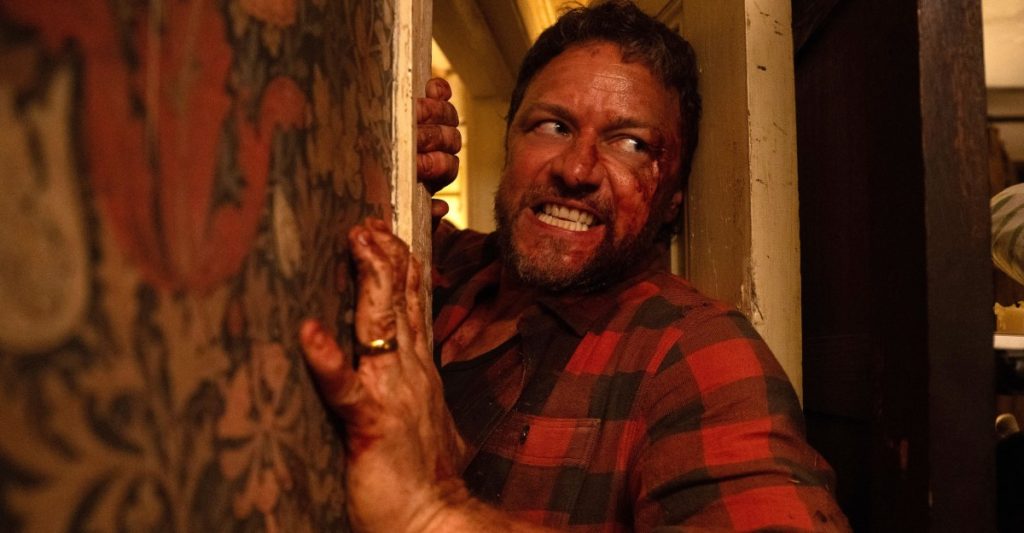
Christian Tafdrup’s taut 2022 Danish horror movie Speak No Evil (streaming on Shudder) has one of the all-time bleak movie endings, a sequence designed to stick in viewers’ memories and haunt their dreams. James Watkins’ 2024 English-language remake approaches that ending… and then adds another half-hour or so of cathartic run-and-gun action, leading up to a radically different, much more Cinemascore-friendly, almost-happily-ever-after-ish conclusion.
It’s a strange approach for a remake, one that’s earned praise and contempt in equal measure. Remakes that change the ending of a memorable movie are nothing new — plenty of online discussion of Speak No Evil has referenced the 1988 Dutch movie The Vanishing, another breathtakingly dark thriller that got an improbable new finale for the American version. But the 2024 Speak No Evil feels unique in adding this much extra business, and pushing the movie into an entirely different genre, all to avoid a tragic wrap-up. It feels like a strange form of fanfiction, someone’s “Yeah, but what if…” fantasy drawn out to almost bafflingly elaborate lengths.
Which got me thinking: What would some of the classic downbeat-ending genre movies look like if they were remade through a Speak No Evil lens? Warning: Spoilers ahead, both for some terrific films and for their imaginary remakes.
For reference: In both versions of Speak No Evil, a quiet and troubled family (father, mother, and anxious preteen daughter) meets a more outgoing family (father, mother, and withdrawn, silent preteen son) on vacation, admires their vivaciousness, and accepts an invite to visit the bubblier family’s remote rural home. In both cases, the second family has a sinister plan for the first family. But while the original 2022 movie ends with that plan coming to awful, calculated fruition, the 2024 remake lets the second family find out what’s going on in time to fight back. As they hole up in a house and improvise defenses, the extensive action edges a little too far toward looking like a much gorier version of Home Alone. Here’s how that might play out for other movies.
Original ending: A group of Antarctic researchers encounter a murderous alien life-form that can mimic individual human forms. One by one, they get picked off and/or replaced by the alien, until only MacReady (Kurt Russell) and Childs (Keith David) are left in the burning wreckage of their compound. Without shelter, stuck in a blizzard at night, and unable to determine whether one or the other of them is secretly a body-snatching alien, they settle down together to share some whiskey and wait for the end.
Speak No Evil-style remake ending: MacReady says, “I’m not an alien, are you?” Childs says, “Nope!” They shake hands and agree to trust each other. The actual alien lunges up from behind a burning building and they punch it into insensibility and throw it into the fire, where it dies screaming. A rescue helicopter shows up and they fly back to civilization and safety.
Six months later, they meet at a Parisian café to reminisce about their Antarctic adventures. Both of them say mildly ominous things that might lead the audience to suspect that one or both of them is still an alien, and creepy background music provides some extra tension. Then MacReady laughs, produces a petri dish and a lighter, and they both test their blood the way they did in the Antarctic lab. Nope, they’re still both human! They leave an extra-big tip for the waiter who has to throw away the bloody petri dish.
Original ending: Dani (Florence Pugh), reeling with grief after her family’s death, accompanies her boyfriend Christian (Jack Reynor) on vacation to the rural Swedish community of the Harga, who turn out to be pagan cultists. They murder Christian’s friends Josh (William Jackson Harper) and Mark (Will Poulter) and lure Christian into a sexual ritual, which Dani spies on. Joining in with the cult’s rituals as their Queen of the May, she weeps and smiles as she oversees a second ritual, where Christian is stuffed into a bear carcass and placed in a burning pyramid to die, along with various other sacrifices.
Speak No Evil-style remake ending: Adrenaline helps Christian fight the drug he was given. Realizing the bear carcass is fire-retardant, he kicks through the burning boards at the back of the pyramid and runs into the woods, where he finds Josh, still bleeding from the head but having escaped his would-be killer. Together, they circle back to the chicken coop to rescue fellow foreign vacationer Simon (Archie Madekwe) and treat his horrific wounds.
Simon improbably shakes off his injuries, as people in movies tend to. The three men improvise weapons and run around the Harga community, taking down anyone who gets in their way. Christian finds Dani and sincerely apologizes for stringing her on for so long. He admits he couldn’t handle her grief and that he’s been weak and immature. She admits that burning him alive for being a terrible boyfriend was going a little too far, but says her experiences with the Harga have been cathartic and that she’s ready to try therapy. They hug it out and agree to break up but stay friends. All four vacationers flee the community together. Josh writes an absolutely killer doctoral thesis. Mark stays dead.
Original ending: Put-upon bureaucrat Sam Lowry (Jonathan Pryce), who frequently imagines himself as a fantasy hero, fights back against the oppressive dystopian bureaucracy he lives in, trying to rescue his dream girl, Jill (Kim Greist). Eventually, he’s captured and tortured, but he finds an escape in his fantasies.
Speak No Evil-style remake ending: We got to see exactly what this looks like in the awful American TV cut of the movie, which eliminates more than half an hour of the run time, cuts the grim ending, and makes Sam’s final fantasy sequence the “real” finale. But for full Speak No Evil-level impact, the remake would need to add significant action, not lose it. Maybe the remake just includes 30 or so more minutes of imaginary-Sam flying around in his silver wingsuit and fighting weird symbolic creatures.
Night of the Living Dead (1968)
Original ending: After resourcefully navigating a hellish zombie siege that kills everyone else holed up with him, Black survivor Ben (Duane Jones) is shot by a posse that casually mistakes him for a ghoul, in an ending that pointedly calls out American racism and uses imagery inspired by photography of American lynchings of Black citizens.
Speak No Evil-style remake ending: Turns out the shot to the head killed Ben, but it was from a low-enough caliber bullet that it didn’t destroy his brain. When the posse lights the pyre they’re using to dispose of corpses, zombie Ben rises and goes after his killers, for an additional 30 minutes of movie action where he pursues and mows down countless sneering rednecks. Eventually, he wanders north, where a cure for zombieism has been found, and he’s revived by helpful doctors. He goes on to teach survival seminars and creates the first modern escape rooms.
Original ending: A religious-themed serial killer known as John Doe (Kevin Spacey) engineers a plan to murder seven people in ways patterned after the seven deadly sins. His last two victims are the detectives pursuing him, William Somerset (Morgan Freeman) and David Mills (Brad Pitt), who he sets up as embodiments of Envy and Wrath, respectively, by arranging for Mills to receive a box that apparently contains the head of Mills’ secretly pregnant wife Tracy (Gwyneth Paltrow). Mills shoots John Doe dead, as Doe had planned all along, and is taken away in a semi-catatonic state.
Speak No Evil-style remake ending: After Somerset’s tragic epigram at the end of the movie, he actually looks in the box and realizes it doesn’t contain Tracy’s head, it contains a crude cartoon doodle of her naked, which really pissed Mills off. Mills goes to see Tracy, who’s doing fine, but he finds clues at her house implicating a second serial killer who was manipulating John Doe.
The remake adds another 30 minutes of underlit, grimy procedural action as he pursues the second man, played by someone else who was big in this era — let’s say Val Kilmer. There is an immense shootout. Kilmer’s character explains his motives at great length before dying. Somerset returns to Mills and promises he burned the offensive doodle. Mills perks up and looks a lot better. They share a beer.
Hamlet (1948, 1969, 1990, 1996, 2000, etc.)
Original ending: Hamlet, prince of Denmark, dithers over whether to kill his treacherous uncle, who murdered Hamlet’s father and married Hamlet’s mother. He pretends to be harmlessly insane to evade suspicion, philosophizes a lot, has some also-treacherous old friends executed, stabs entirely the wrong person, and is generally a jerk to his girlfriend. Eventually, nearly everyone dies, Hamlet included.
Speak No Evil-style remake ending: Turns out the poison that kills most of the key players at the end of the play was a faulty batch made by those rascals Rosencrantz and Guildenstern, who were busy bantering when they brewed it, and missed a few key steps. Hamlet, Laertes, and Gertrude all recover.
Hamlet castigates his mother, who points out that women don’t really get to make a lot of choices in 1600s Denmark, and castigates Hamlet right back for being a wishy-washy whiner. He philosophizes about this at length before admitting he’s indecisive and a bit of a drama queen. He lets Horatio talk him into naming Fortinbras king because Hamlet would be terrible at it. Tens of thousands of theater students around the world take up his “Should I have made an actual decision at some point in the past four hours?” speech for theatrical auditions.
Original ending: Robert Oppenheimer (Cillian Murphy) is crucial to America’s wartime efforts to invent an atomic bomb. He becomes death, destroyer of worlds. The U.S. predictably shrugs off his moral concerns about the bomb and rushes it into production. Politician Lewis Strauss (Robert Downey Jr.) engineers Oppenheimer’s political downfall, and suffers in turn. History unfolds.
Speak No Evil-style remake ending: In the film’s final flashback to Oppenheimer’s meeting with Einstein, the latter also tells the former, “By the way, watch out for that Strauss guy, he’s a snake.” Remembering this advice in the present, Oppenheimer rushes to his lab and uses his advanced knowledge of physics to invent a time machine.
The final 30 minutes of the movie features Oppenheimer leaping through time, punching Strauss in the face at various moments in history for cathartic effect, then eventually sabotaging the atomic bomb research, but winning World War II anyway by time traveling to Germany at the beginning of the war and shooting Hitler (Taika Waititi, reprising his role from Jojo Rabbit) in the head. Standing over Hitler’s body, he says “Now I am become death, the destroyer of your lame ass.” Nobody wins an Oscar for this version.
Original ending: Oilman Daniel Plainview (Daniel Day-Lewis) ends his long rivalry with Eli Sunday (Paul Dano) in a definitive fashion. There is, as promised, blood.
Speak No Evil-style remake ending: Daniel and Eli talk for 30 additional minutes about milkshakes and metaphors for capitalism. A thousand more milkshake memes are spawned. There is no blood. The resultant class-action lawsuit bankrupts director Paul Thomas Anderson.






















